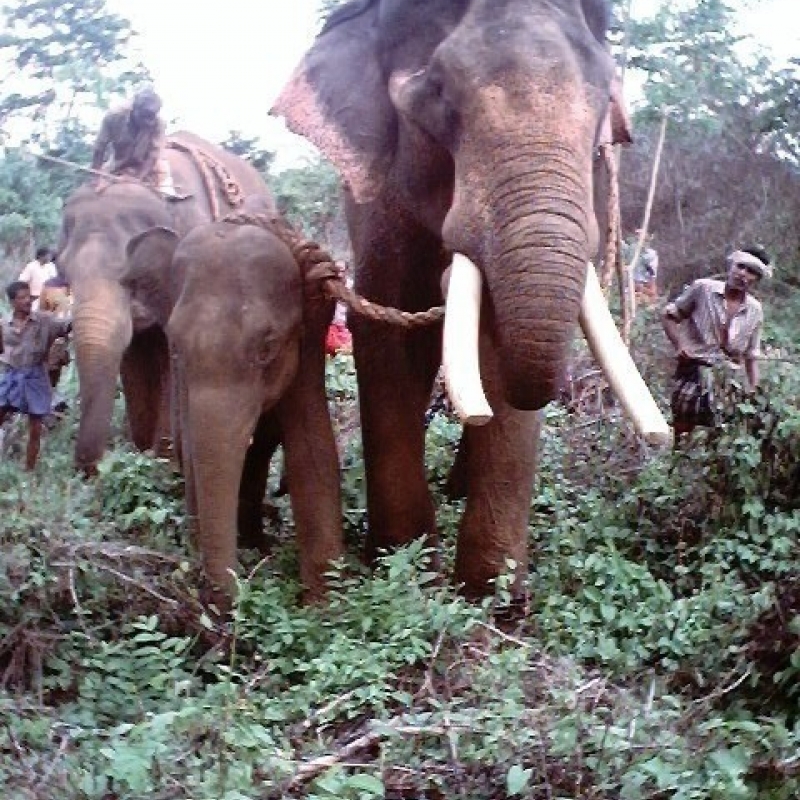The practice of capturing wild Asian elephants and then taming and training them for work originated approximately 4000 years ago. Originally used as war elephants on battlefields, they came to be used extensively as draught animals in the logging of forests, in timber yards, in clearing land for development, and in temples, becoming living symbols of status in society. The earliest written evidence of the use of elephants in temples (though some sources claim that elephants were used in temples centuries even millennia ago) is from Tamil Nadu, where they were used to carry water to the sanctums and also for transportation. Their use in temples and work yards eventually evolved into education, research and entertainment (e.g., circuses). An increase in elephant capture from the wild also led to the use of trained (kumki) elephants in capture operations. All these roles require extensive training of the animal. This article looks at existing and past methods of capture, taming and training methods in popular use and scientific advancements in the field of humane elephant training. The subcontinent has had a long history of elephant capture, primarily in the north-eastern and southern parts of India.
With a ban on elephant capture in place since the 1970s, capture operations are now restricted to conflict-mitigation strategies. Sometimes elephants are captured if the life of the elephant is in danger by some accident or natural causes. In recent times, increasing political pressure and public agitation have necessitated the removal of elephants from conflict zones. Such captures, however, are part of the larger debate about elephant conservation, particularly in the Anthropocene era, as elephants are being pushed into the category of endangered species. Criticism has been voiced against the training of elephants after they are captured, which often involves traditional techniques of establishing dominance, in which punishment plays an important role.
Elephant Capture in Ancient Texts
vārīkarmavaśāvilēābhanavidhi-
bhyāṁcānugatyātatai-
vāpātēnatatēāvapātataitī-
hēbhagraha: pañcadhā
(By the methods of working a trap pen and enticement with cows,
and by pursuit, also by assault, and by pits,
thus the catching of elephants is five-fold.)
— Matangalila by NīlakantaŚarma[1]
The Matangaleela, a rendition of the Gajashastra, by the Sanskrit poet Nilakanta, talks of five different techniques that can be used for capturing elephants—pens or stockades; using female elephants as bait; noosing the elephant; following the animal till it tires out and then restraining it; and placing a noose in a small pit and then attracting the elephant to the pit using food.
Following capture, the training methods used vary greatly depending on geographical location and local practices—from extremely harsh negative reinforcement to more humane positive reinforcement or rewards-based training. The training could be ‘open’ (direct contact between the restrained elephant and the trainer/mahout) or ‘closed’ (the animal is kept inside the kraal [wooden enclosure] till the training is complete).
The following section describes some training methods that are in practice, particularly in South India.
Training the Captured Animal
Chapter 12 of the Matangaleela/Gajashastra discusses the techniques to be followed while training an elephant; it lists commands, training protocols, and more importantly, the character of the mahout. In most places, there are local tribal communities who are associated with such practices. In parts of the Nilgiris, for example, the communities involved are the Paniyas, Kurubas, Jainik-kurubas, Betta-kurubas, and sometimes, the Kattunaikkas. In Anamalai, the elephant catchers, trainers, and mahouts hail predominantly from the Malasar community, with a few individuals from the Kadar community. These communities have their own methods of tending to and taming an elephant—each with its own pros and cons. Elephant training is widely debated, especially with regard to ethical and welfare issues; thus, it is important to study training protocols and amalgamate best practices used in different regions.
The Theory of Training
The traditional way of training an elephant involves establishing dominance through various methods. Forceful submission—the most common of these—has drawn criticism globally. This method is mostly used during open training of the animals, a practice in Northeast India and Southeast Asia. During open training, the elephant has more opportunity to display resistance and aggression, potentially endangering the trainer’s life. This method, therefore, leads to the animal being subject to more torture to control its behaviour.
The second most common technique involves depriving the animal of food and water during its initial days in captivity in order to subdue its aggression and resistance. This is not a recommended practice because denying sustenance is denying the animals of their basic rights. The animal is only fed once it starts responding to commands. This technique is used in both open and closed training protocols.
In the closed training system, the elephant is confined within a standard 12 feet x 12 feet kraal. The floors of the kraals are made of wooden slats with gaps in between that prevent them from becoming damp. The roof is made of tiles or sheets. A small tank or large drum of water is provided. The approach of the Malasars of Anamalai and the Kurubas of Mudumalai is similar—they use the same vocal and tactile commands and employ a mixture of positive reinforcement/rewards-based training and punishment. According to them, recognising the thin line between punishment and cruelty allows for correct practices. Punishment in this context does not necessarily involve physically harming the animal, although physical punishment is sometimes used. Rather, it is meant to prevent undesirable behaviour, such as charging at the mahout, displaying conspecific aggression, causing damage to property, or becoming unpredictable or disobedient at work. This ‘punishment’ can involve threatening the animal with loud or harsh vocal commands, showing the stick, splashing water on the elephant’s face and, sometimes, mild physical punishment. More importantly, both communities mentioned above start the training process by feeding the animal.
The first step is usually familiarisation with the mahout’s voice, which is done through repeated verbal commands. Initially, a captured wild elephant will display aggressive behaviour, resistance and it will try to hit the wooden bars of the kraal. A raised voice, or a sudden dominance gesture by the mahout, usually prevents this. Once the elephant starts responding to the mahout positively, it begins to use its trunk to accept food and it is taught to obey the command ‘Jharak!’ by standing close to the bars of the kraal to take food (twigs, bamboo, grass stalks or sugarcane).
Usually, in about 10 days, the animal would have started to accept the mahout and take food directly from his hand. About a week later, after the mahout has further established his relationship with the elephant, he will enter the kraal to tend to any wounds, bruises or abrasions incurred during the capture.
Recently, some Western zoos and elephant management centres have adopted a system called ‘protected contact’, wherein the elephant is kept inside a larger enclosure and has minimal physical contact with the keeper, thereby avoiding risk. This may not be ideal, however, when putting these animals up for departmental activities such as drive operations or patrolling.
According to members of the Malasar community, the ideal training method begins with habituation, which is a gradual process requiring much patience. Mahouts who lack the necessary patience often fail in this approach and then resort to violence. Gradual habituation through vocal and limited tactile communication through the bars of the kraal establishes a bond between the mahout and the animal. This method differs from others in that it does not push the tolerance limit of the animal. The emphasis is on winning the elephant’s trust, not breaking its spirit.
Understanding Elephant Biology and Behaviour
Most elephant management, in the wild and in captivity, does not take the animal’s biology, physiology, or behaviour into consideration. The elephant, with its well-developed forebrain and hippocampus, is known to display emotions[2], possess human-like features such as self-recognition in mirrors[3] and engage in cooperative problem-solving.[4] A comprehensive understanding of all these traits is imperative for managing elephants in captivity.
The importance of learning must be considered. Rewards-based positive reinforcement techniques are based on Pavlov’s theory of classical conditioning. In captivity, an animal that is given opportunities to learn on its own becomes relatively easier to manage. For instance, animals rescued as very young calves (one year or less) and brought into captivity often have difficulty grazing or browsing in the wild as adults, as they have become accustomed to subsisting on cut fodder in their stalls and have not learnt to graze freely. This occurs less in forest camp settings, where there is a social network and adult females foster and teach the young ones.
With their large and highly convoluted hippocampi, elephants have extremely complex emotions and spatial memories. As a result, they suffer from complex conditions equivalent to post-traumatic stress disorder (PTSD). Exemplars that study elephants, both in the wild and in captivity, testify that they exhibit grief, learn skills, play, practice allomothering and use tools.
A minimal restraint setting provides elephants with opportunities to display their natural behaviours, such as free movement, dusting, playing in water, free grazing and making dietary switches between grazing and browsing; it also provides mating opportunities. However, in environments other than forest camps, animals are often confined in small spaces and restrained with many chains. As a result, they develop psychological disorders such as stereotypy (obsessively repetitive behaviours). It is known that for most species in captivity, prolonged confinement can be a major cause of stress, as is evident from their stereotypic behaviour. In elephants, this is characterised by head bobbing, head swaying and irregular ear flapping. There are even recorded instances of extreme stereotypic behaviour, such as self-mutilation, which is relatively less common or almost unknown in less-confined animals.
Prolonged confinement that restricts animals’ ability to express their natural, instinctive behaviours can cause them to develop other abnormalities, such as limb displacement or ankylosed limbs, foot disorders and other health conditions. When an animal is denied opportunities to vary its diet, this leads to digestive problems, such as impaction, which can be fatal if not attended to early. This phenomenon is currently evident and common among captive elephants in Kerala.
While kraal training involves establishing a relationship with the animal and the elephant listening to the vocal and tactile commands of the mahout, it is important to have follow-up sessions for the elephant and its mahout to bond more deeply. Initially, the mahout will establish a daily routine of taking the animal to the river and having long scrubbing/bathing sessions, during which the mahout communicates with the animal. He will take the animal for walks and for fodder collection and keep its confinement to a minimum. The elephants in training are brought out and taken to the river with the help of kumkis and these sessions provide an opportunity for observational learning. During this initial period, the mahout, sitting atop the elephant, also slowly teaches it foot commands. It is important for the officer of the elephant camp to design a training protocol, which is strictly followed by the elephant–mahout duo, which includes the animal’s systematic upkeep and management.
Conclusion
Today, the very phenomenon of elephant captivity is being debated. It is true that captivity per se is stressful for elephants and that we need to move towards phasing out of holding elephants in captivity, particularly in the commercial sector. However, with increasing human–elephant conflict, habitat loss and behavioural changes in the species, more animals are being forced into captivity, either in the form of conflict-related captures or as rescued calves. In this context, a comprehensive understanding of historic management practices gains importance, but these must also be updated with our current understanding of the species, including advancements in the fields of biology, physiology, animal behaviour and applied psychology. While the number of elephants in captivity must be minimised as much as possible, the existing stock in captivity must also get the best training, upkeep and management.
Notes
[1] Edgerton, The Elephant-lore of the Hindus.
[2] Bradshaw and Schore, ‘How Elephants are Opening Doors’.
[3] Plotnik et al., ‘Self-Recognition in an Asian Elephant’.
[4] Plotnik et al., ‘Elephants Know When They Need a Helping Trunk in a Cooperative Task’.
Bibliography
Bradshaw, G.A. and A.N. Schore. ‘How Elephants are Opening Doors: Developmental Neuroethology, Attachment and Social Context’, Ethology 113, (2007): 426–36.
Edgerton, F. The Elephant-lore of the Hindus: The Elephant Sports (Matangalila) of Nilakanth. New Delhi: Motilal Banarsidass Publishers, 1985.
Plotnik, J.M., F.B.M. de Waal, and D. Reiss. ‘Self-Recognition in an Asian Elephant’, Proceedings of the National Academy of Sciences 103, no. 45 (2006): 17053–7.
Plotnik, J.M., R. Lair, W. Suphachoksahakun, and F.B.M de Waal. ‘Elephants Know When They Need a Helping Trunk in a Cooperative Task’, Proceedings of the National Academy of Sciences 108, no. 12 (2011): 5116–21.













